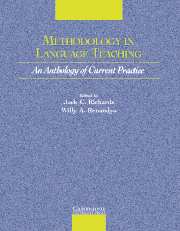Book contents
- Frontmatter
- Contents
- Acknowledgments
- Introduction
- Section I Approaches to Teaching
- Section 2 Lesson Planning and Classroom Management
- Section 3 Classroom Dynamics
- Section 4 Syllabus Design and Instructional Materials
- Section 5 Task and Project Work
- Section 6 Learning Strategies
- Section 7 Teaching Grammar
- Chapter 13 Seven Bad Reasons for Teaching Grammar – and Two Good Ones
- Chapter 14 Addressing the Grammar Gap in Task Work
- Chapter 15 Grammar Teaching – Practice or Consciousness-Raising?
- Section 8 Teaching Pronunciation
- Section 9 Teaching Speaking
- Section 10 Teaching Listening
- Section 11 Teaching Vocabulary
- Section 12 Teaching Reading
- Section 13 Teaching Writing
- Section 14 Assessment
- Section 15 Technologies in the Classroom
- Section 16 Professional Development
- Credits
- Author Index
- Subject Index
- References
Chapter 14 - Addressing the Grammar Gap in Task Work
Published online by Cambridge University Press: 10 November 2010
- Frontmatter
- Contents
- Acknowledgments
- Introduction
- Section I Approaches to Teaching
- Section 2 Lesson Planning and Classroom Management
- Section 3 Classroom Dynamics
- Section 4 Syllabus Design and Instructional Materials
- Section 5 Task and Project Work
- Section 6 Learning Strategies
- Section 7 Teaching Grammar
- Chapter 13 Seven Bad Reasons for Teaching Grammar – and Two Good Ones
- Chapter 14 Addressing the Grammar Gap in Task Work
- Chapter 15 Grammar Teaching – Practice or Consciousness-Raising?
- Section 8 Teaching Pronunciation
- Section 9 Teaching Speaking
- Section 10 Teaching Listening
- Section 11 Teaching Vocabulary
- Section 12 Teaching Reading
- Section 13 Teaching Writing
- Section 14 Assessment
- Section 15 Technologies in the Classroom
- Section 16 Professional Development
- Credits
- Author Index
- Subject Index
- References
Summary
INTRODUCTION
A current interest in methodology is task-based approaches to teaching. These involve the use of tasks that engage learners in meaningful interaction and negotiation focusing on completion of a task. Learners' grammar needs are determined on the basis of task performance rather than through a predetermined grammar syllabus. However, whether learners develop acceptable levels of grammatical proficiency through such an approach is problematic. This paper reviews current views about the status of grammar learning through task work and suggests that grammar learning can be addressed at several different stages during task performance: prior to the task, during the task, and after the task. Examples are given of how this can be achieved in materials' design and in the classroom.
The status of grammar-focused teaching or, as it is currently referred to, form-focused instruction (see Doughty & Williams, 1998) has undergone a major reassessment since the 1970s. The advent of communicative language teaching ostensibly saw the demise of grammar-based instruction: Grammatical syllabuses were superseded by communicative ones based on functions or tasks; grammar-based methodologies such as the Presentation-Practice-Production (P-P-P) lesson format underlying the Situational Approach gave way to function- and skill-based teaching; and accuracy activities such as drills and grammar practice were replaced by fluency activities based on interactive small-group work. This led to the emergence of a ‘fluency-first’ pedagogy (Brumfit, 1979) in which students' grammar needs are determined on the basis of their performance on fluency tasks rather than predetermined by a grammatical syllabus.
Information
- Type
- Chapter
- Information
- Methodology in Language TeachingAn Anthology of Current Practice, pp. 153 - 166Publisher: Cambridge University PressPrint publication year: 2002
References
Accessibility standard: Unknown
Why this information is here
This section outlines the accessibility features of this content - including support for screen readers, full keyboard navigation and high-contrast display options. This may not be relevant for you.Accessibility Information
- 7
- Cited by
